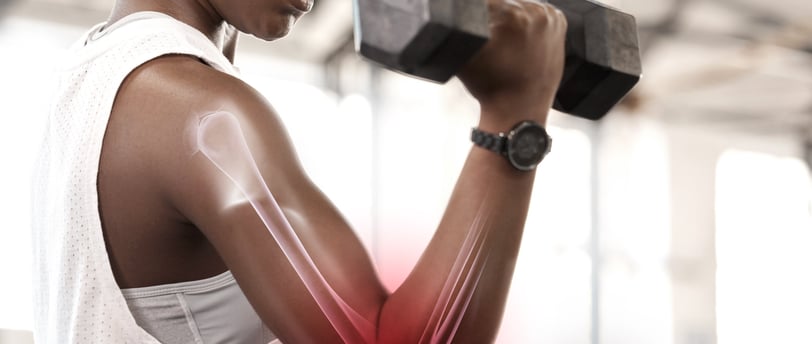Be the best version of yourself
The Importance of Bone Health as We Age: Tips to Prevent Osteoporosis
9/24/20244 min read


As we age, maintaining strong, healthy bones becomes increasingly important. One of the biggest concerns for women, especially in midlife, is the risk of osteoporosis, a condition where bones become weak and brittle. However, there are effective ways to protect your bone health through lifestyle choices like exercise, nutrition, and supplementation.
What are Osteoporosis and Osteopenia?
Osteoporosis is a condition characterized by a significant decrease in bone density, making bones weak and prone to fractures. It often progresses silently, without symptoms, until a break occurs. Osteopenia is a precursor to osteoporosis, where bone density is lower than normal but not yet severe enough to be classified as osteoporosis. Both conditions increase the risk of fractures, but osteopenia indicates that you are at risk and can still take steps to prevent further bone loss.
Some of the key risks associated with osteoporosis include:
1. Fractures
Osteoporosis dramatically increases the risk of bone fractures, particularly in areas like the hips, spine, and wrists. These fractures can occur even from minor falls or, in severe cases, from simple movements like bending or coughing. Most fractures require surgery, with all the risks that are involved.
2. Complications After Fractures
Complications from fractures can be severe, especially in older adults. For example, hip fractures often require hospitalization and surgery, and recovery may involve long periods of immobility, increasing the risk of infections, blood clots, and other complications. Recovery from fractures, especially in the hip and spine, is often slow and can lead to long-term disability as many people never regain their full mobility. This can limit a person's ability to perform daily tasks and lead to a loss of independence.
3. Chronic Pain
Vertebral fractures from osteoporosis can cause severe and persistent pain. This chronic pain may reduce the quality of life, making physical activity difficult and contributing to a sedentary lifestyle, which can further weaken bones.
4. Deformity
Osteoporosis can lead to a stooped or hunched posture (known as kyphosis) due to fractures in the vertebrae. This not only affects appearance but can also restrict lung capacity, making breathing more difficult and increasing the risk of respiratory issues.
5. Emotional and Mental Health Impact
Living with the fear of fractures and physical limitations can affect mental well-being. Many people with osteoporosis experience anxiety about falling or fracturing a bone, which can lead to social withdrawal, depression, and a decline in overall life satisfaction.
What can we do to support our Bone Health
Bone density naturally decreases with age, and for women, this process accelerates after menopause due to a drop in estrogen levels. But the good news is that there are ways to prevent this, helping you stay strong and active as you age.
1. The Role of Exercise in Bone Health
One of the best ways to strengthen your bones and prevent osteoporosis is through regular exercise, particularly weight-bearing and impact-focused activities.
- Weight Lifting: Strength training stimulates bone formation by placing stress on the bones, prompting them to rebuild and become stronger. Lifting weights not only helps maintain bone density but also strengthens the muscles surrounding your bones, reducing the risk of falls and fractures.
- Plyometrics and Jumping: High-impact exercises like jumping, skipping, or plyometric drills (which include explosive movements like jump squats or box jumps) help increase bone density. These activities exert pressure on the bones, which signals them to adapt and grow stronger over time.
- Consistency is Key: For best results, aim to incorporate weight-bearing exercises and plyometrics into your weekly routine. Even 20-30 minutes, three to four times per week, can make a big difference in maintaining bone strength.
2. Nutrition for Strong Bones
Good nutrition is the foundation of bone health. Your bones need key nutrients to stay strong. Calcium is the building block of bones, and getting enough of it is crucial as we age. Include foods rich in calcium such as:
- Dairy products (milk, yogurt, cheese)
- Leafy greens (kale, spinach, broccoli)
- Almonds
- Fortified foods (like certain plant-based milks and cereals)
If you find it difficult to get enough calcium through food alone, a supplement can help meet your daily requirements. Adults generally need around 1,000-1,200 mg of calcium per day, depending on age and gender.
3. The Vital Role of Vitamin D
While calcium is essential, it can’t do its job without the help of vitamin D, which aids in calcium absorption in the body. To ensure your vitamin levels stay optimal, there are several important factors to keep in mind:
- Sunlight: One of the best sources of vitamin D is sunlight, as your skin produces this vitamin when exposed to UV rays. However, during the colder months or for those living in areas with limited sun exposure, it may be necessary to boost your intake through food or supplements.
- Vitamin D-Rich Foods: Foods like fatty fish (salmon, mackerel), fortified dairy products, and egg yolks provide vitamin D. Still, most people struggle to get enough from diet alone.
- Vitamin D Supplementation: For adults, the recommended daily intake of vitamin D is 600-800 IU, but some individuals may need more, especially if they live in low-sunlight areas. A vitamin D supplement is often recommended to ensure adequate levels and to support optimal bone health.
Additional Tips for Bone Health: things to avoid
- Limit Alcohol and Caffeine: Excessive alcohol and caffeine can interfere with calcium absorption, so it's important to consume these in moderation.
- Quit Smoking: Smoking accelerates bone loss and increases the risk of fractures, so quitting is one of the best steps you can take for your bones (and overall health).
- Maintain a Healthy Weight: Being underweight can increase bone loss while being overweight puts extra strain on your bones. Maintaining a balanced weight helps support overall bone health.
Conclusion
Taking proactive steps to strengthen your bones through exercise, proper nutrition, and the right supplements is essential for long-term health. Incorporating weightlifting, plyometrics, and calcium-rich foods, while ensuring you get enough vitamin D, can significantly reduce the risk of osteoporosis as you age. Start small, stay consistent, and your bones will thank you!
References
Osteoporosis or Low Bone Mass in Older Adults: United States, 2017–2018, CDC (https://www.cdc.gov/nchs/products/databriefs/db405.htm)
Information on osteoporosis and the role of exercise and nutrition, NIH Osteoporosis and Related Bone Diseases (https://www.bones.nih.gov/health-info/bone/osteoporosis/overview)
Details on bone health, including risk factors, prevention, and management strategies, International Osteoporosis Foundation (https://www.osteoporosis.foundation/patients)
The role of calcium and vitamin D in bone health, Harvard Medical School – Calcium and Vitamin D, (https://www.health.harvard.edu/womens-health/two-keys-to-strong-bones-calcium-and-vitamin-d)
Recommendations on exercise, nutrition, and supplements for bone health, Mayo Clinic (https://www.mayoclinic.org/diseases-conditions/osteoporosis/symptoms-causes/syc-20351968)
Contacts
fitover40withmarina@outlook.com +41 76 229 19 32
Socials
Subscribe to our free newsletter and get high-protein meal recipes that will make you feel full longer, grow your muscles, and achieve your goals faster! Directly into your inbox!


